#1960s Mary W
Explore tagged Tumblr posts
Text




























Different Mary Werbelow's photos taken when she was a model, circa late 60s/early 70s.
Ebay.
#Mary Werbelow#1960s Mary W#1970s Mary W#Mary W model#model#muse#artist#dancer#oil painting artist#drawing artist
8 notes
·
View notes
Text
Photo taken, perhaps, in the mid-late 60s?
In his instagram you'll see he's written a memoir book about his time spent with his friend Mary and Jim Morrison titled "Love Her Madly: Jim Morrison, Mary and Me"
https://www.instagram.com/bill.cosgrave/

Mary Werbelow
from Bill Cosgrave's insta
#Mary Werbelow#1960s Mary W#Mary W model#1960s model#model#muse#artist#oil painting artist#drawing artist#Bill Cosgrave#Jim Mary and Me#Love her Madly: Jim Morrison Mary and Me#Love her Madly#LoveherMadlybook#Love Her Madly Book#Mary W muse
11 notes
·
View notes
Text

The Dick Van Dyke Show, 1963
#tumblrgallery.xyz#gif#the dick van dyke show#mary tyler moore#laura petrie#dick van dyke#rob petrie#santa#dance#dancing#dancer#christmas#television#tv#b&w#the alan brady show presents#1963#1960s
117 notes
·
View notes
Text


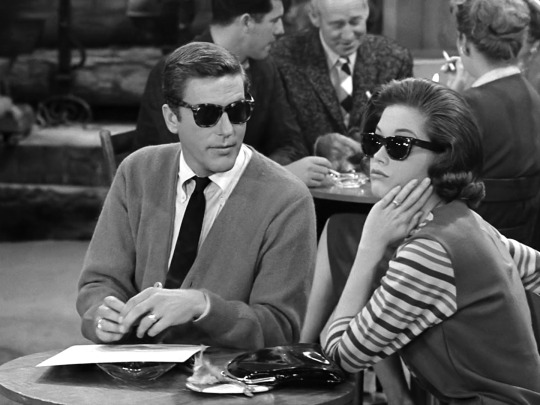



The Dick Van Dyke Show: S02E10 The Secret Life Of Buddy and Sally
#the dick van dyke show#dick van dyke#mary tyler moore#tv shows#my screenshots#screenshots#1960s#60s#soupy's#b/w
29 notes
·
View notes
Text







PART 2 OF 2 -- A DAY IN THE LIFE OF AN AMERICAN EXPAT -- LONDON BRANCH.
NOTE:^Part 2 of a previous photo-dump of the same photosession I posted a few months back. Been lagging it on these!
PIC(S) INFO: Spotlight on the second set from the massive photo-session of the late, great Sharon Tate in her London, England apartment, photographed on September 18, 1965 by George Elam.
"For the time being, Sharon isn't giving movies a thought. She left recently for London to continue her romance with Poland's famed, shaggy-haired director, Roman Polanski. "I've known him for nine months," says Sharon. "We have a wonderful relationship. I don't know if I'll marry him. He hasn't asked me yet." If Sharon does wed, her film career and Ransohoff's half a million dollar investment in her will go down the drain. "I'll give up acting the second I'm married," says Sharon, which leads many observers to believe it won't happen for some time."
-- NEW YORK SUNDAY NEWS, c. December 18, 1966
Sources: http://sensationalsharontate.blogspot.com/2009/11/another-interview-with-sharon-at.html & Flickr.
#Sharon Tate#Modeling#Photography#1960s#Miss Sharon Tate#Vintage Style#Photosession#60s girls#60s Style#Sixties#60s fashion#60s#Feminine beauty#George Elam photography#Photoshoot#B&W photography#Retro Style#George Elam#Hair and Makeup#60s glamour#London UK#Hollywood Actress#Actress#Female beauty#Film Actress#Movie Actress#London#B&W#1965#Sharon Marie Tate
8 notes
·
View notes
Note
i think you do a really impressive job balancing comprehensive/concise while referencing a lot of complex frameworks(contexts? schools of thought? lol idk what to call that. big brain ideas) but if you have any readings specifically on the institution of psychiatry topic that you would recommend/think are relevant, I'd be interested. it's absolutely not a conversation that's being had enough and I want to be able to articulate myself around it
yes i have readings >:)
first of all, the anti-psychiatry bibliography and resource guide is a great place to start getting oriented in this literature. it's split by sub-topic, and there are paragraphs interspersed throughout that give summaries of major thinkers' positions and short intros to key texts.
it's from 1979, though, so here are some recs from the last 4 decades:
overview critiques
mind fixers: psychiatry's troubled search for the biology of mental illness, by anne harrington
psychiatric hegemony: a marxist theory of mental illness, by bruce m z cohen
desperate remedies: psychiatry's turbulent quest to cure mental illness, by andrew scull
psychiatry and its discontents, by andrew scull
madness is civilization: when the diagnosis was social, 1948–1980, by michael e staub
contesting psychiatry: social movements in mental health, by nick crossley
the dsm & pharmacy
dsm: a history of psychiatry's bible, by allan v horwitz
the dsm-5 in perspective: philosophical reflections on the psychiatric babel, by steeves demazeux & patrick singy
pharmageddon, by david healy
pillaged: psychiatric medications and suicide risk, by ronald w maris
the making of dsm-iii: a diagnostic manual's conquest of american psychiatry, by hannah s decker
the myth of the chemical cure: a critique of psychiatric drug treatment, by joanna moncrieff
the book of woe: the dsm and the unmaking of psychiatry, by gary greenberg
prozac on the couch: prescribing gender in the era of wonder drugs, by jonathan metzl
the creation of psychopharmacology, by david healy
the bitterest pills: the troubling story of antipsychotic drugs, by joanna moncrieff
psychiatry & race
the protest psychosis: how schizophrenia became a black disease, by jonathan metzl
administrations of lunacy: racism and the haunting of american psychiatry at the milledgeville asylum, by mab segrest
the peculiar institution and the making of modern psychiatry, 1840–1880, by wendy gonaver
what's wrong with the poor? psychiatry, race, and the war on poverty, by mical raz
national and cross-national contexts
mad by the millions: mental disorders and the early years of the world health organization, by harry yi-jui wu
psychiatry and empire, by sloan mahone & megan vaughan
ʿaṣfūriyyeh: a history of madness, modernity, and war in the middle east, by joelle m abi-rached
surfacing up: psychiatry and social order in colonial zimbabwe, 1908–1968, by lynette jackson
the british anti-psychiatrists: from institutional psychiatry to the counter-culture, 1960–1971, by oisín wall
crime, madness, and politics in modern france: the medical concept of national decline, by robert a nye
reasoning against madness: psychiatry and the state in rio de janeiro, 1830–1944, by manuella meyer
colonial madness: psychiatry in french north africa, by richard keller
madhouse: psychiatry and politics in cuban history, by jennifer lynn lambe
depression in japan: psychiatric cures for a society in distress, by junko kitanaka
inheriting madness: professionalization and psychiatric knowledge in 19th century france, by ian r dowbiggin
mad in america: bad science, bad medicine, and the enduring mistreatment of the mentally ill, by robert whitaker
#sorry this is SO MANY things lmao#i wld recommend starting with harrington or scull as an intro and then maybe look at one of the more topic-specific texts#depending on what interests you specifically#book recs#psychiatry
723 notes
·
View notes
Text

Johnnie Walker
Former pirate radio disc jockey who went to Radio 1 and later became a stalwart of Radio 2
Johnnie Walker, who has died aged 79, began his career as a disc jockey in the offshore pirate radio era of the mid-1960s. He was one of four pirate DJs – the others were John Peel, Tony Blackburn and Kenny Everett – who came to symbolise that time and continued to prosper in its aftermath.
The pirate radio stations, of which the most famous was Radio Caroline, were set up on ships and disused forts in the North Sea, avoiding British regulation by broadcasting from international waters and providing pop music to a British teen market not catered for by the BBC stations of the era.

Their DJs offered a fantasy version of adolescence from clued-up older-brother substitutes who, in the case of Peel, Blackburn and Walker, were former public schoolboys. Within this dreamscape Walker’s persona was that of the smooth-talking kid who got the girl. His theme tune was Duane Eddy’s 1960 American hit Because They’re Young, which more than 40 years later was still being reworked into the intro to Walker’s Radio 2 drivetime slot.
The pirates went on air in the dying months of Sir Alec Douglas-Home’s Conservative government, and Harold Wilson’s succeeding Labour administration devoted an extraordinary amount of energy to suppressing this sound of youth. The Marine Offences Act of 1967 brought an end to prosecution-free pirate radio on 14 August, but Walker could still be heard proclaiming the cause of freedom and the unreasonableness of adults from Radio Caroline the next day.
Peel, Everett and Blackburn were among the DJs who abandoned the rusting boats off the coast for a comfortable billet at BBC Broadcasting House in Langham Place, London, where Radio 1 was launched that September to meet the demand that the pirate stations had identified. The illegal broadcasting had confirmed Walker’s place in teenage affections, but by the spring of 1968 Caroline too had buckled under the pressure to stop broadcasting, and a year later Walker decamped to Radio 1, taking over its lunchtime slot.
Walker was born Peter Dingley in Hampton-in-Arden near Birmingham, the fourth of five children of Trevor Dingley, a salesman for W Canning & Co, an electroplating company, and his wife, Mary (nee Waters). At Solihull school, Peter failed his O-levels because, he claimed, he did not want a piece of paper to determine his path in life. So, at 16, he became a car salesman while moonlighting as a dance hall DJ under the name “Peter Dee”.
In May 1966 he joined Swinging Radio England, on a ship off the coast of Essex, and changed his name to Johnnie Walker. A couple of months later he switched to Radio Caroline, the first, and the most fashionable, of the pirates.
Walker was a radio natural, laconic but warm, and somebody who clearly cared about the music he was playing. His taste was for the adult oriented rock that dominated the pre-punk 1970s – or at least its album charts – bands such as Fleetwood Mac, Steely Dan and Steve Harley’s Cockney Rebel.
At BBC Radio 1, this brought him into conflict with a management that had become enamoured with Top 20-dominated playlists. The Bay City Rollers, in those ancient times the teenybopper rage, were, Walker suggested, “musical garbage”. He told callers put out by his views to “take a running jump”. Thus, by 1976 he had quit the station to seek his fortune in California.
He did not really find it, and after spells with the stations KSAN in San Francisco and WHFS in Bethesda, Maryland, he returned to Britain in the early 1980s. He worked for local commercial stations until 1987, when he rejoined Radio 1. He then went to the BBC’s Greater London Radio from 1988 until 1990, when he was sacked for suggesting that the ousting of the prime minister, Margaret Thatcher, would have people “dancing in the streets”.
Despite that setback, his career in the 1990s, with Radio 1, LBC and Classic Gold was a success. In 1998 he joined Radio 2, which by then was playing the very same music he had been promoting three decades earlier when it was young and supposedly fresh.
In 1999 the progress of his revitalised career was disrupted when he became the subject of a classic News of the World undercover sting. Walker was videoed taking cocaine and offering to provide the “tycoons” – NoW reporters – with the services of sex workers. He was suspended by the BBC, went into drug rehabilitation and after being fined £2,000 for possession of cocaine was reinstated at Radio 2. The NoW’s work had made it difficult, the magistrate observed, for him to receive a fair trial.
In 2003 Walker took absence from his show for cancer treatment, from which he made a good recovery. In 2009 he began presenting the show that would define his later career, Sounds of the 70s.
He was appointed MBE in 2006, and in 2013 he received the gold badge of the British Academy of Songwriters, Composers and Authors. His eponymous autobiography was published in 2007. In 2008-09 he was an adviser to the Richard Curtis film The Boat That Rocked, an attempt to recapture the pirate radio era.
Walker announced in early October that he was retiring from radio after 58 years, having been diagnosed with idiopathic pulmonary fibrosis, and presented his final Sounds of the 70s show at the end of that month.
He is survived by his second wife, Tiggy (nee Jarvis), whom he married in 2003, and by the son and daughter of his first marriage, to Frances Kum, which ended in divorce.
🔔 Johnnie Walker (Peter Waters Dingley), radio presenter, born 30 March 1945; died 31 December 2024
Daily inspiration. Discover more photos at Just for Books…?
23 notes
·
View notes
Text

LETTERS FROM AN AMERICAN
January 1, 2025
Heather Cox Richardson
Jan 01, 2025
Twenty-five years ago today, Americans—along with the rest of the world—woke up to a new century date…and to the discovery that the years of work computer programmers had put in to stop what was known as the Y2K bug from crashing airplanes, shutting down hospitals, and making payments systems inoperable had worked.
When programmers began their work with the first wave of commercial computers in the 1960s, computer memory was expensive, so they used a two-digit format for dates, using just the years in the century, rather than using the four digits that would be necessary otherwise—78, for example, rather than 1978. This worked fine until the century changed.
As the turn of the twenty-first century approached, computer engineers realized that computers might interpret 00 as 1900 rather than 2000 or fail to recognize it at all, causing programs that, by then, handled routine maintenance, safety checks, transportation, finance, and so on, to fail. According to scholar Olivia Bosch, governments recognized that government services, as well as security and the law, could be disrupted by the glitch. They knew that the public must have confidence that world systems would survive, and the United States and the United Kingdom, where at the time computers were more widespread than they were elsewhere, emphasized transparency about how governments, companies, and programmers were handling the problem. They backed the World Bank and the United Nations in their work to help developing countries fix their own Y2K issues.
Meanwhile, people who were already worried about the coming of a new century began to fear that the end of the world was coming. In late 1996, evangelical Christian believers saw the Virgin Mary in the windows of an office building near Clearwater, Florida, and some thought the image was a sign of the end times. Leaders fed that fear, some appearing to hope that the secular government they hated would fall, some appreciating the profit to be made from their warnings. Popular televangelist Pat Robertson ran headlines like “The Year 2000—A Date with Disaster.”
Fears reached far beyond the evangelical community. Newspaper tabloids ran headlines that convinced some worried people to start stockpiling food and preparing for societal collapse: “JANUARY 1, 2000: THE DAY THE EARTH WILL STAND STILL!” one tabloid read. “ALL BANKS WILL FAIL. FOOD SUPPLIES WILL BE DEPLETED! ELECTRICITY WILL BE CUT OFF! THE STOCK MARKET WILL CRASH! VEHICLES USING COMPUTER CHIPS WILL STOP DEAD! TELEPHONES WILL CEASE TO FUNCTION! DOMINO EFFECT WILL CAUSE A WORLDWIDE DEPRESSION!”
In fact, the fix turned out to be simple—programmers developed updated systems that recognized a four-digit date—but implementing it meant that hardware and software had to be adjusted to become Y2K compliant, and they had to be ready by midnight on December 31, 1999. Technology teams worked for years, racing to meet the deadline at a cost that researchers estimate to have been $300–$600 billion. The head of the Federal Aviation Administration at the time, Jane Garvey, told NPR in 1998 that the air traffic control system had twenty-three million lines of code that had to be fixed.
President Bill Clinton’s 1999 budget had described fixing the Y2K bug as “the single largest technology management challenge in history,” but on December 14 of that year, President Bill Clinton announced that according to the Office of Management and Budget, 99.9% of the government's mission-critical computer systems were ready for 2000. In May 1997, only 21% had been ready. “[W]e have done our job, we have met the deadline, and we have done it well below cost projections,” Clinton said.
Indeed, the fix worked. Despite the dark warnings, the programmers had done their job, and the clocks changed with little disruption. “2000,” the Wilmington, Delaware, News Journal’s headline read. “World rejoices; Y2K bug is quiet.”
Crises get a lot of attention, but the quiet work of fixing them gets less. And if that work ends the crisis that got all the attention, the success itself makes people think there was never a crisis to begin with. In the aftermath of the Y2K problem, people began to treat it as a joke, but as technology forecaster Paul Saffo emphasized, “The Y2K crisis didn’t happen precisely because people started preparing for it over a decade in advance. And the general public who was busy stocking up on supplies and stuff just didn’t have a sense that the programmers were on the job.”
As of midnight last night, a five-year contract ended that had allowed Russia to export natural gas to Europe by way of a pipeline running through Ukraine. Ukraine president Volodymyr Zelensky warned that he would not renew the contract, which permitted more than $6 billion a year to flow to cash-strapped Russia. European governments said they had plenty of time to prepare and that they have found alternative sources to meet the needs of their people.
Today, President Joe Biden issued a statement marking the day that the new, lower cap on seniors’ out-of-pocket spending on prescription drugs goes into effect. The Inflation Reduction Act, negotiated over two years and passed with Democratic votes alone, enabled the government to negotiate with pharmaceutical companies over drug prices and phased in out-of-pocket spending caps for seniors. In 2024 the cap was $3,400; it’s now $2,000.
As we launch ourselves into 2025, one of the key issues of the new year will be whether Americans care that the U.S. government does the hard, slow work of governing and, if it does, who benefits.
Happy New Year, everyone.
LETTERS FROM AN AMERICAN
HEATHER COX RICHARDSON
#Con Man#Mike Luckovich#Letters From An American#heather cox richardson#history#American History#Y2K#do your job#the work of government#Inflation Reduction Act#technology management#the hard slow work of governing
14 notes
·
View notes
Photo

She was destined to be my Gradiva, the one who moves forward, my victory, my wife.
- Salvador Dali on Gala
Dali always maintained that without his wife, Gala, he would never have been the icon of art as he became.
Gala’s real name was Helena Ivanovna Diakonova, a Russian born in Kazan in 1894. She was 10 years older than Dalí and, when they met in 1929, she was married to the poet Paul Éluard and mother to a little girl. She also had a lover, Max Ernst, who painted her in a number of portraits. It was love at first sight.
In his Secret Life, Dalí wrote: “She was destined to be my Gradiva, the one who moves forward, my victory, my wife.” The name Gradiva comes from the title of a novel by W. Jensen, the main character of which was Sigmund Freud. Gradiva was the book’s heroine and it was her who brought psychological healing to the main character.
She immediately became his muse. Gala is a frequent model in Dalí’s work, often in religious roles such as the Blessed Virgin Mary in the painting The Madonna of Port Lligat.

In the early 1930s, Dalí started to sign his paintings with his and her name as “it is mostly with your blood, Gala, that I paint my pictures”. Gala acted as his agent, very aggressively fighting for his rights with gallery owners and buyers. She was also using tarot cards to influence Dalí’s career decisions. According to most accounts, Gala had a strong sex drive and, throughout her life, had numerous extramarital affairs (among them with her former husband Paul Éluard), which Dalí encouraged, since he was a practitioner of candaulism. Also, Salvador Dalí claims to be a virgin and completely impotent as he was afraid of women’s anatomy and Gala publicly assumes her affairs with other men. Still, it seems that their relationship was quite harmonic and lucrative for both sides.
He wrote: “I would polish Gala to make her shine, make her the happiest possible, caring for her more than myself, because without her, it would all end.”
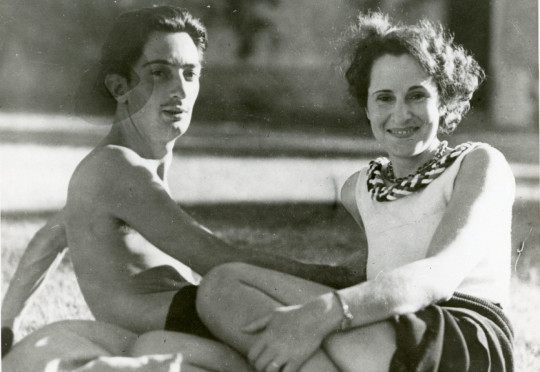
But nothing lasts forever. At the end of the 1960s, their relationship started to fade away, and for the rest of their lives, it was just smouldering pieces of their bygone passion. In 1968, the painter bought Gala a castle in Púbol, Girona, and it was agreed that the painter could not go there without her prior permission. Gala spent much of her time there in the company of young men, for whom she spent a fortune. In his turn, Dali saved himself for the company of attractive young ladies, although he didn’t want anything from them but their beauty. It was said that they held weekly orgies, though, by all accounts, the artist himself didn’t participate except to watch.
In 1980, at the age of 76, Dali was forced to retire due to palsy. The motor disorder left him unable to hold a brush, and as his condition worsened, he became less tolerant of Gala’s continued affairs. Gala was also using income from Dali’s art to lavish money and gifts on her lovers, who were mostly young male artists. One day, the artist had enough. He beat Gala so badly, he broke two of her ribs. To calm him down, Gala gave him large doses of Valium and other sedatives, which made him lethargic. She then allegedly gave him “unknown quantities of one or more types of amphetamine,” which caused “irreversible neural damage.”
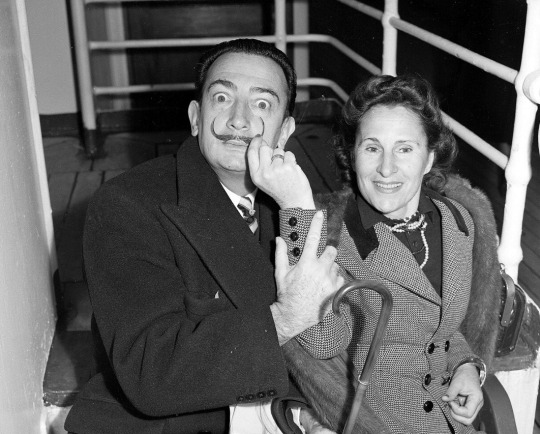
Gala Dalí died in Port Lligat, Spain, on June 10, 1982, following a severe case of the flu. She was buried in Púbol, Spain, on the grounds of a castle that was a gift from her husband. At the time of her death, she was involved in an affair with a 22-year-old Jesus Christ Superstar actor named Jeff Fenholt for whom she left Dalí. But when Gala died, Dalí’s life became dull. He stopped eating and scratched his face. He was constantly shouting and crying. He outlived his wife by seven years.
They lived together for 53 years.
#dali#salvador dali#quote#gala#gravida#artist#surrealism#muse#beauty#art#gala dali#marriage#life#history#art history#spanish#artsims#culture
364 notes
·
View notes
Text
Jester Hairston
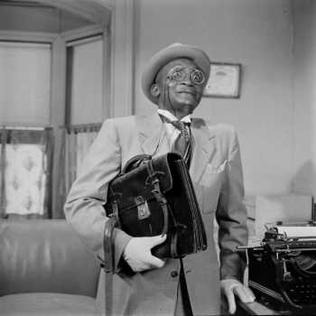
By Life Magazine via Google Images-Photographer Loomis Dean., Fair use, https://en.wikipedia.org/w/index.php?curid=28896923
Jester Joseph Hairston (July 9, 1901 – January 18, 2000) was an American composer, songwriter, arranger, choral conductor and actor. He was regarded as a leading expert on black spirituals and choral music. His notable compositions include "Amen," a gospel-tinged theme from the film Lilies of the Field and a 1964 hit for the Impressions, and the Christmas song "Mary's Boy Child."
Hairston was born in Belews Creek, a rural community on the border of Stokes, Forsyth, Rockingham and Guilford counties in North Carolina. His grandparents had been slaves. At an early age, he and his family moved to Homestead, Pennsylvania, just outside Pittsburgh, where he graduated from high school in 1921. Hairston was very young when his father was killed in a job-related accident. Hairston was raised by his grandmother while his mother worked. Hairston heard his grandmother and her friends talking and singing about plantation life and became determined to preserve this history through music.
Hairston initially majored in landscape architecture at Massachusetts Agricultural College in the 1920s. He became involved in various church choirs and choral groups, and accompanist Anna Laura Kidder saw his potential and became his benefactor. Kidder offered Hairston financial assistance to study music at Tufts University. from which he graduated in 1929. He was one of the first black students admitted to Tufts. Later he studied music at the Juilliard School.
Hairston pledged the Chi chapter of the Kappa Alpha Psi fraternity in 1925. He worked as a choir conductor in the early stages of his career. His work with choirs on Broadway eventually led to singing and acting parts in plays, films, radio programs and television shows.
Hairston sang with the Hall Johnson Choir in Harlem for a time but was nearly fired from the all-black choir because he had difficulty with the rural dialects that were used in some of the songs. He had to shed his Boston accent and relearn the country speech of his parents and grandparents. Johnson had told him: "We're singing ain't and cain't and you're singing shahn't and cahn't and they don't mix in a spiritual." The choir performed in many Broadway shows, including The Green Pastures. In 1936, the choir was asked to visit Hollywood to sing for the film The Green Pastures. Russian composer Dimitri Tiomkin heard Hairston and invited him to what would become a 30-year collaboration in which Hairston arranged and collected music for films. In 1939, Hairston married Margaret Swanigan. He wrote and arranged spirituals for Hollywood films as well as for high school and college choirs around the country.
Hairston wrote the song "Mary's Boy Child" in 1956. He also arranged the song "Amen", which he dubbed for the Sidney Poitier film Lilies of the Field, and arranged traditional Negro spirituals.[16] Most of Hairston's film work was in the field of composing, arranging and choral conducting. He also acted in more than 20 films, mostly in small roles, some uncredited. Hairston starred in John Wayne's The Alamo (1960), in which he portrayed "Jethro," a slave owned by Jim Bowie. In 1962’s To Kill a Mockingbird Hairston portrayed the uncredited role of the father of accused rapist Tom Robinson. In 1967’s In the Heat of the Night, Hairston portrayed the butler of a wealthy racist being investigated for murder. In both films, Hairston shot scenes along side men who won an Academy Award for Best Actor in those respective films for portraying white Southerners navigating their jobs through a racially divided culture.
In 1961, the U.S. State Department appointed Hairston as Goodwill Ambassador. He traveled all over the world teaching and performing the folk music of the slaves. In the 1960s, he held choral festivals with public high-school choirs, introducing them to Negro spiritual music, and sometimes led several hundred students in community performances. His banter about the history of the songs along with his engaging personality and sense of humor endeared him to many students.
During his nationwide travels, Hairston checked local phone books for other Hairstons and reunited many people on his family tree, both black and white. He composed more than 300 spirituals. He was the recipient of many honorary doctorates, including a doctorate from the University of Massachusetts in 1972 and a doctorate in music from Tufts in 1977.
In his later years, Hairston served as a cultural ambassador for American music, traveling to numerous countries with choral groups that he had assembled. In 1985, he took the Jester Hairston Chorale, a multiracial group, to sing in China at a time when foreign visitors would rarely appear there.
Hairston died in Los Angeles of natural causes in 2000 at age 98. For his contribution to the television industry, Hairston has a star on the Hollywood Walk of Fame located at 6201 Hollywood Boulevard. He is interred at Inglewood Park Cemetery, Inglewood, California.
31 notes
·
View notes
Text
Dinner and Evening Dresses of 1910 -
Left 1910 (December) Dinner dress by Beer, Les Modes - photo by Félix. From les-modes.tumblr.com/page/14; fixed spots w Pshop 725X1920.
Right 1910 (December) Dinner dress by Maison Agnès, Les Modes - photo by Félix. From les-modes.tumblr.com/page/23 fixed spots w Pshop 752X1920.
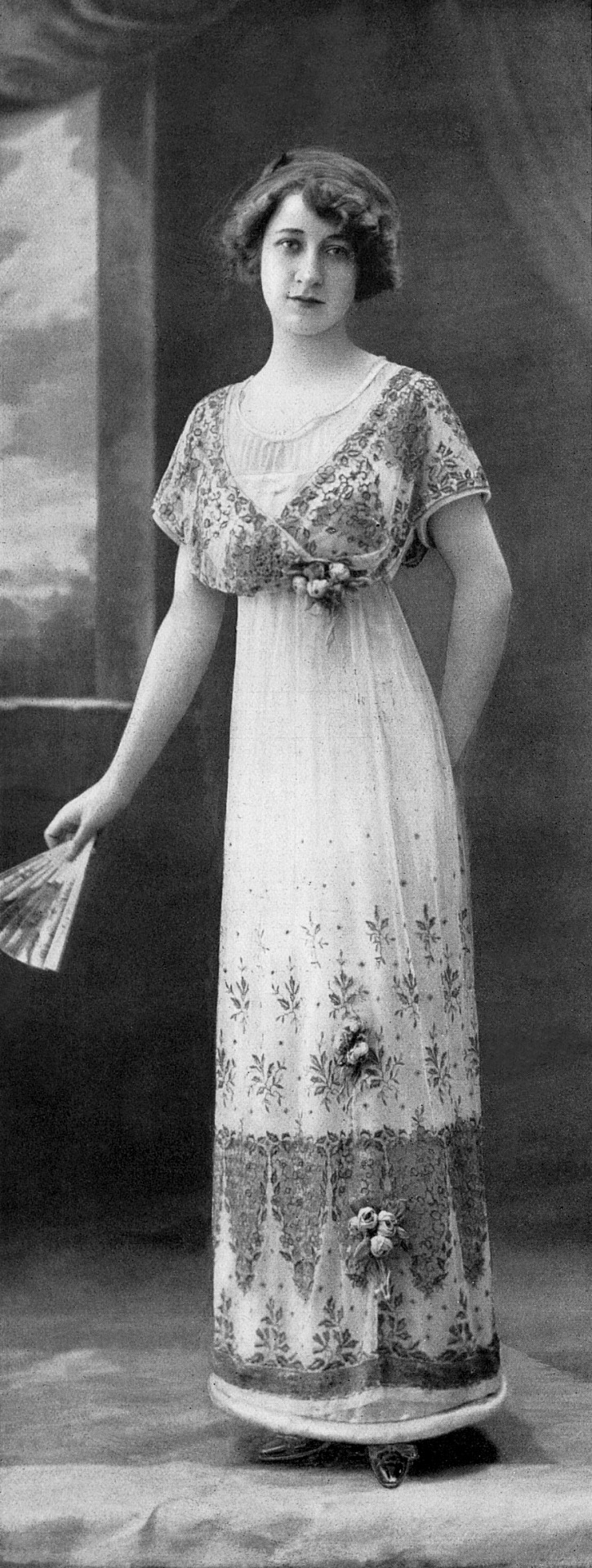

Left 1910 (August issue) Evening gown by Drecoll, photo Reutlinger. From les-modes.tumblr.com/image/519495531581280X1815.
Right 1910 (June) Eevening gown by Rivain & Cie, Les Modes - photo by Félix. From les-modes.tumblr.com/page/27; fixed vertical flaws & spots w Pshop 682X1635
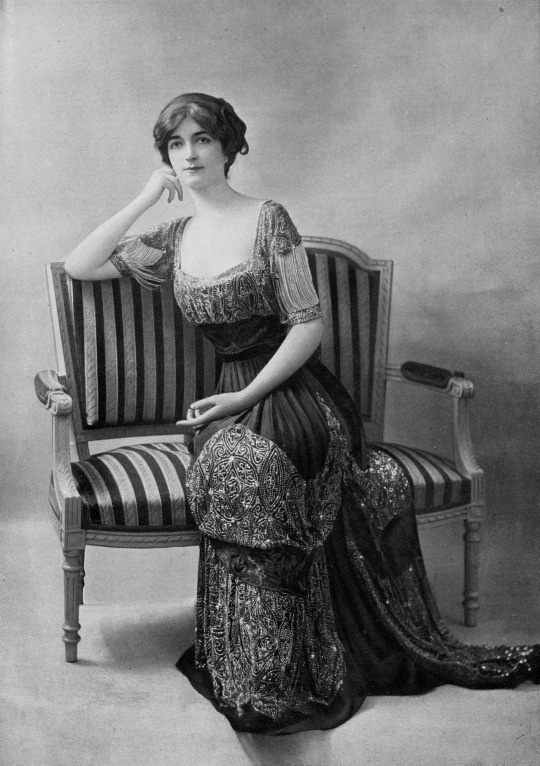

Left 1910 (May) Les Modes Evening gown by Bernard, photo by Félix. From les-modes.tumblr.com/search/1910s; abated streaks & fixed spots w Pshop 1280X1811.
Right 1910 (May) Les Modes Evening gown by Laferriére. .From les-modes.tumblr.com/search/1910s/page/13 1000X1393.

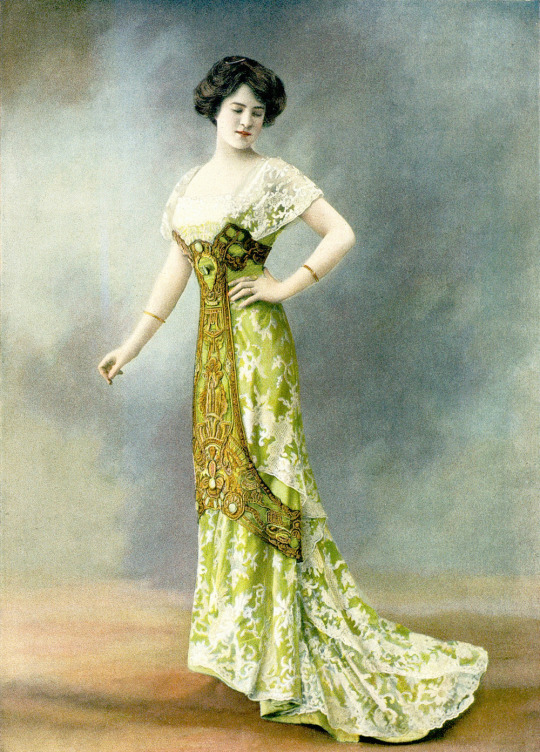
Left. 1910 Baroness Gerda von Chappuis (Mrs F. A. Konig) by Sir John Lavery (auctioned by Christie's) From the discontinued Athenaeum Web site; cropped 679X980.
Right. 1910 Evening dress by ? (location ?). From sartorialadventure.tumblr.com 360X1200.


Left 1910 Evening dress by ? (location ?). From sartorialadventure.tumblr.com 709X1400.
Right 1910 Evening dress by House of Worth (location ?). From costumehistory.tumblr.com/post/180312871593/shewhoworshipscarlin-evening-dress-by-house-of 1280X1679.

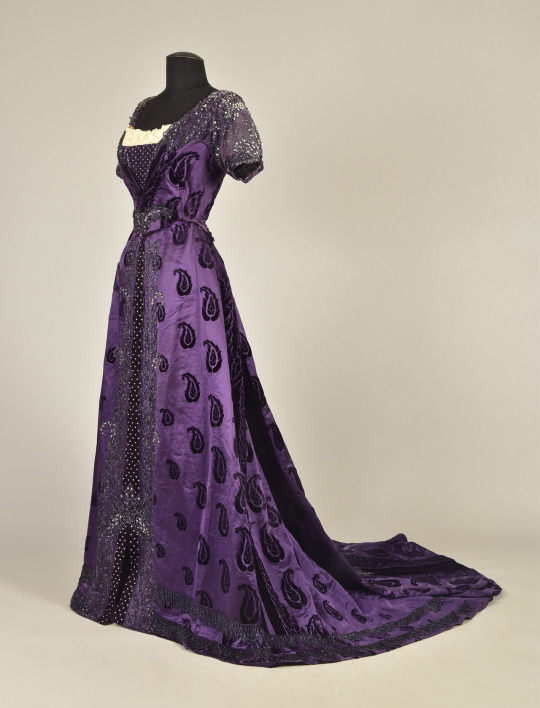
Left 1910 Lady by Arthur von Ferraris (auctioned by Michael Zeller). From Wikimedia 714X1003.
Right 1910 Marie Cécile Ney d'Elchingen (1867-1960), wife of Joachim, 5th prince Murat by Giovanni Boldini (auctioned by Christie's). From their Web site 1718X3212.
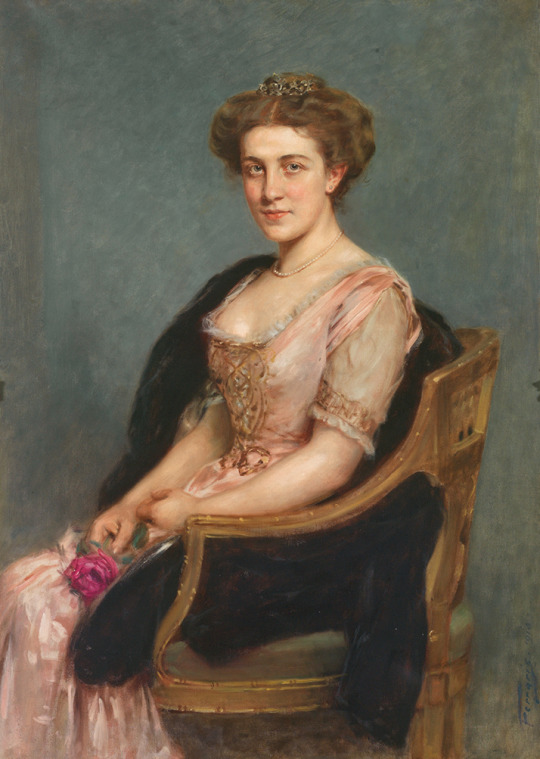
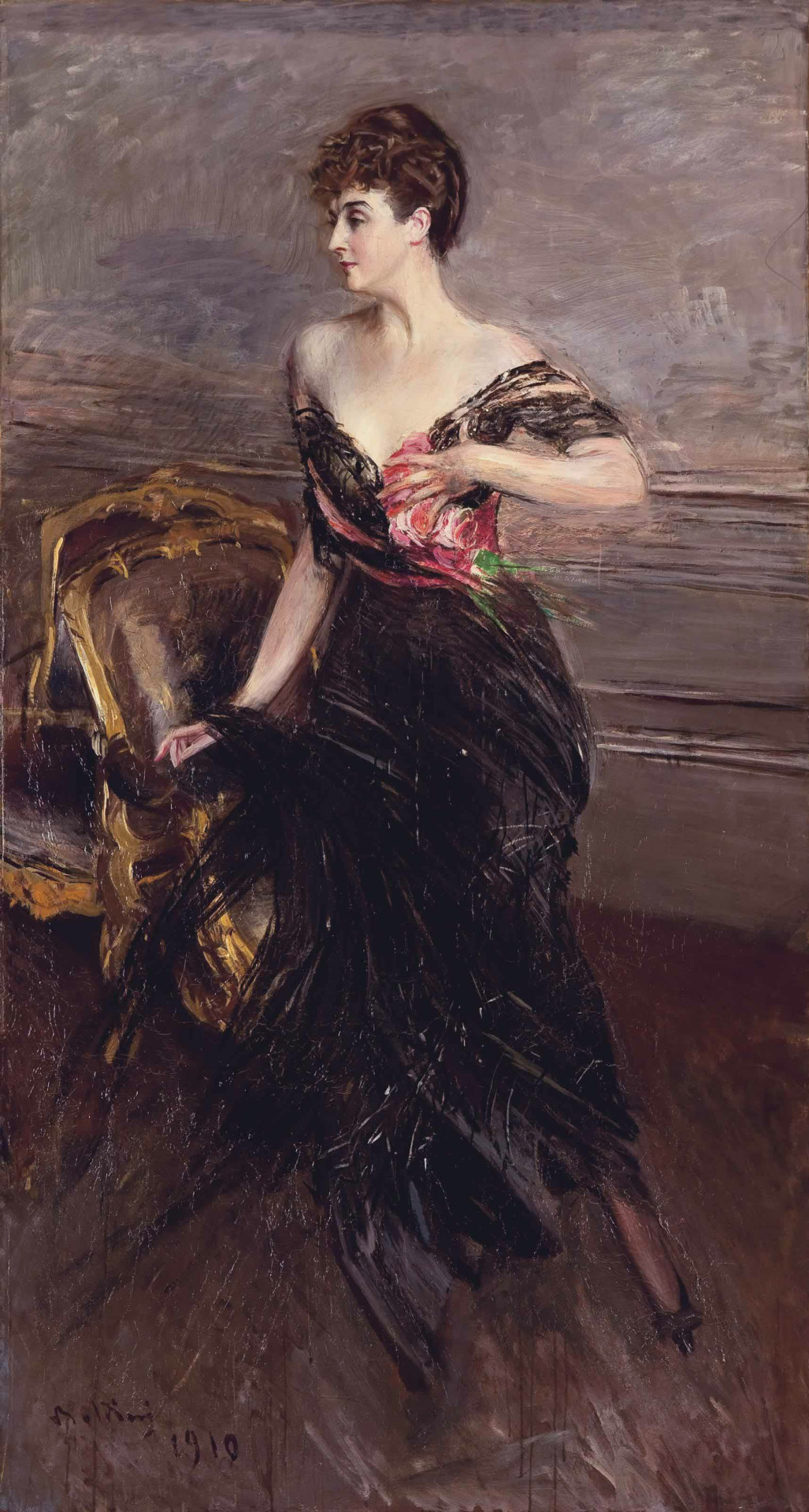
Left 1910 Mrs. E. L. Doyen by Giovanni Boldini (private collection). From arthive.com/sl/artists/8960~Giovanni_Boldini/works/270437~Portrait_of_Madame_Doyen 1765X3600.
Right 1910 Mrs. Mabel Brooks of Kinmount by Sir Hubert von Herkomer (auctioned). From pinterest.com/ustava51/живописьженский-образ/ 1187X1920.
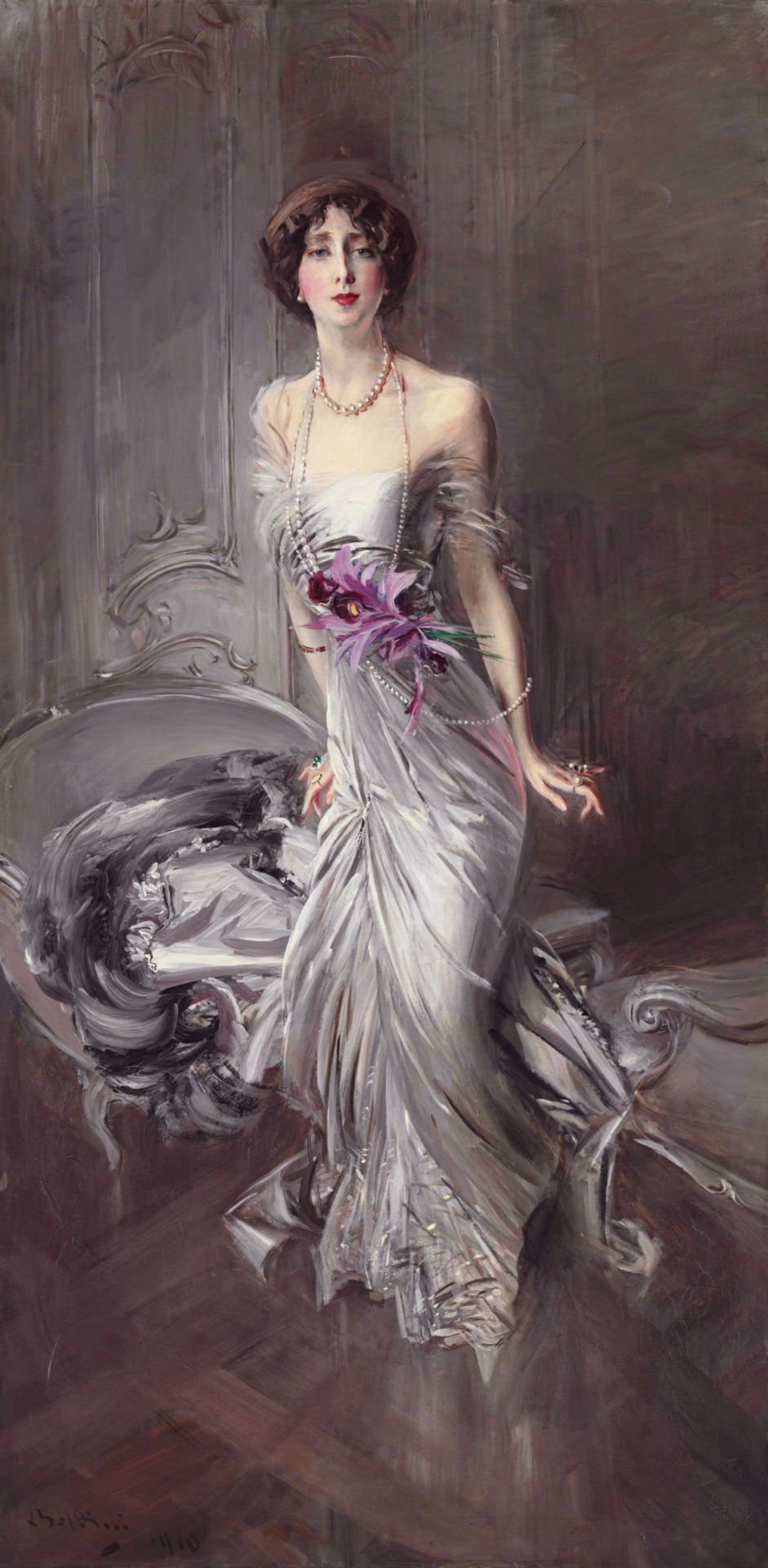
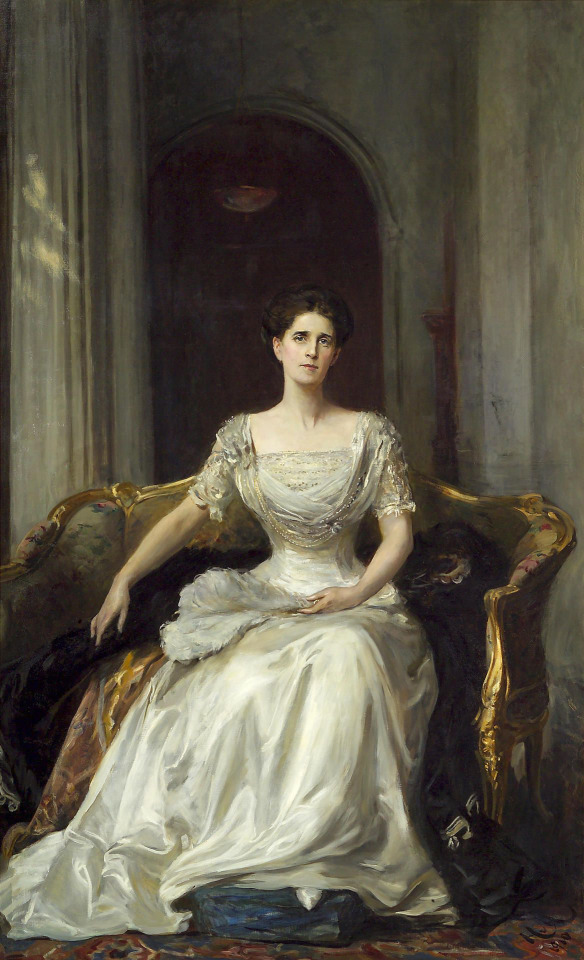
Left 1910 Peacock dress by ? (Metropolitan Museum of Art - New York City, New York, USA). From buzzfeed.com/deesims/10-stunning-gowns-to-reaffirm-the-belief-you-were-n5qq 638X1681.
Right 1910 Queen Mary photo signed May Posted to Foro Dinastias by Maravilha on 7 August 2010 1160X1600.


ca. 1910 Madame Duchesse Vendome and Prince Charles-Philippe d'Orléans by Boissonnas & Taponier. From eBay; fixed spots and removed mono-color tint 669X1067.

#1910s fashion#1910 fashion#Belle Époque fashion#Edwardian fashion#evening dress#dinner dress#Auguste Beer#Félix#close skirt#wide feathered hat#Maison Agnès#Drecoll#Reutlinger#Rivain & Cie#Augusta Bernard#Madeleine Laferrière#Gerda von Chappuis#John Lavery#House of Worth#Arthur von Ferraris#Marie Cécile Ney d'Elchingen#Giovanni Boldini#Mrs. E. L. Doyen#Mrs. Mabel Brooks of Kinmount#Hubert von Herkomer#Queen Mary#May of Teck#duchesse de Vendome#Boissonnas & Taponier#Jean-Charles Worth
70 notes
·
View notes
Text





Mary Werbelow modelling pics from the mid 60s.
First photo (and maybe second) taken by Peter Gowland.
Photo 3 is from 1968, from youtube.
Photo 4 Mary is pctured by Bill Cosgrave and originally comes from his instagram but this one is from here.
All other photos are from Ebay.
#Mary Werbelow#1960s Mary W#model#1960s model#1960s fashion#Peter Gowland#Bill Cosgrave#muse#artist#dancer
6 notes
·
View notes
Text

References & Footnote
Abraham, R. C. 1933. The Tiv people. Lagos: Government Printer.
Afigbo, A. E. 1971. ‘The Aro of southeastern Nigeria: a socio-historical analysis of legends of their origins’, African Notes 6: 31–46.
Aglietta, M. and A. Orle´an (eds.) 1995. Souverainete´, le´gitimite´ de la monnaie. Paris: Association d’E´ conomie Financie‘re (Cahiers finance, e´thique, confiance).
Akiga Sai, B. 1939. Akiga’s story; the Tiv tribe as seen by one of its members. Translated and annotated by Rupert East. London: Published for the International African Institute by the Oxford University Press.
Akiga Sai, B. 1954. ‘The “descent” of the Tiv from Ibenda Hill’ (translated by Paul Bohannan), Africa: Journal of the International African Institute 24: 295–310.
Akin, D. and J. Robbins 1998. An introduction to Melanesian currencies: agencies, identity, and social reproduction, in D. Akin and J. Robbins (eds.), Money and modernity: state and local currencies in Melanesia, 1–40. Pittsburgh: University of Pittsburgh Press.
Bohannan, P. 1954. ‘The migration and expansion of the Tiv’, Africa: Journal of the International African Institute 24: 2–16.
Bohannan, P. 1955. ‘Some principles of exchange and investment among the Tiv’, American Anthropologist 57: 60–7.
Bohannan, P. 1958. ‘Extra-processual events in Tiv political institutions’, American Anthropologist 60: 1–12.
Bohannan, P. 1959. ‘The impact of money on an African subsistence economy’, Journal of Economic History 19: 491–503.
Carrier, J. 2010. Handbook of economic anthropology. Cheltenham: Edward Elgar.
Curtin, P. D. 1969. The Atlantic slave trade: a census. Madison, WI: University of Wisconsin Press.
Dike, K. O. and F. Ekejiuba 1990. The Aro of south-eastern Nigeria, 1650–1980: a study of socio-economic formation and transformation in Nigeria. Ibadan: University Press.
Dorward, D. C. 1976. ‘Precolonial Tiv trade and cloth currency’, International Journal of African Historical Studies 9: 576–91.
Douglas, M. 1951. ‘A form of polyandry among the Lele of the Kasai’, Africa: Journal of the International African Institute 21: 1–12. (As Mary Tew.)
Douglas, M. 1958. ‘Raffia cloth distribution in the Lele economy’, Africa: Journal of the International African Institute 28: 109–22.
Douglas, M. 1960. ‘Blood-debts and clientship among the Lele’, Journal of the Royal Anthropological Institute of Great Britain and Ireland 90: 1–28.
Douglas, M. 1963. The Lele of the Kasai. London: Oxford University Press.
Douglas, M. 1964. ‘Matriliny and pawnship in Central Africa’, Africa: Journal of the International African Institute 34: 301–13.
Douglas, M. 1966. Purity and danger: an analysis of concepts of pollution and taboo. London: Routledge and Kegan Paul.
Douglas, M. 1982. In the active voice. London: Routledge and Kegan Paul. Downes, R. M. 1977. Tiv religion. Ibadan: Ibadan University Press.
Ekejiuba, F. I. 1972. ‘The Aro trade system in the nineteenth century’, Ikenga 1(1): 11–26, 1(2): 10–21. Eltis, D., S. D. Behrent, D. Richardson and H. S. Klein 2000. The transatlantic slave trade: a database. Cambridge: Cambridge University Press.
Equiano, O. 1789. The interesting narrative of the Life of Olaudah Equiano: or, Gustavus Vassa, the African. New York: Modern Library Edition, 2004.
Graeber, D. 2001. Toward an anthropological theory of value: the false coin of our own dreams. New York: Palgrave.
Grierson, P. 1977. The origins of money. London: Athlone Press.
Guyer, J. I. 2004. Marginal gains: monetary transactions in Atlantic Africa. Chicago, IL: University of Chicago Press.
Harris, R. 1972. ‘The history of trade at Ikom, Eastern Nigeria’, Africa: Journal of the International African Institute 42: 122–39.
Herbert, E. W. 2003. Red gold of Africa: copper in precolonial history and culture. Madison, WI: University of Wisconsin Press.
Ingham, G. 2004. The nature of money. Cambridge: Polity Press. Isichei, E. 1976. A history of the Igbo people. London: Basingstoke. Jones, G. I. 1939. ‘Who are the Aro?’, Nigerian Field 8: 100–3.
Jones, G. I. 1958. ‘Native and trade currencies in southern Nigeria during the eighteenth and nineteenth centuries’, Africa: Journal of the International African Institute 28: 43–56.
Latham, A. J. H. 1971. ‘Currency, credit and capitalism on the Cross River in the pre-colonial era’, Journal of African History 12: 599–605.
Latham, A. J. H. 1973. Old Calabar 1600–1891: the impact of the international economy upon a traditional society. Oxford: Clarendon Press.
Laum, B. 1924. Heiliges Geld: Eine historische Untersuchung ueber den sakralen Ursprung des Geldes. Tu¨ bingen: J. C. B. Mohr.
Le´vi-Strauss, C. 1949. Les structures e´le´mentaires de la parente´. Paris: EHESS.
Lovejoy, P. F. and D. Richardson 1999. ‘Trust, pawnship, and Atlantic history: the institutional foundations of the Old Calabar slave trade’, American Historical Review 104: 333–55.
Lovejoy, P. F. and D. Richardson 2001. ‘The business of slaving: pawnship in Western Africa, c. 1600–1810’, Journal of African History 42: 67–84.
Malamoud, C. (ed.) 1988. Lien de vie, noeud mortel. Les repre´sentations de la dette en Chine, au Japon et dans le monde indien. Paris: EHESS.
Northrup, D. 1978. Trade without rulers: pre-colonial economic development in south-eastern Nigeria. Oxford: Clarendon Press.
Nwauwa, A. O. 1991. ‘Integrating Arochukwu into the regional chronological structure’, History in Africa 18: 297–310.
Ottenberg, S. 1958. ‘Ibo oracles and intergroup relations’, Southwestern Journal of Anthropology 14: 295–317.
Ottenberg, S. and P. Ottenberg 1962. Afikpo markets: 1900–1960, in P. Bohannan and G. Dalton (eds.), Markets in Africa, 118–69. Chicago, IL: Northwestern University Press.
Partridge, C. 1905. Cross River natives: being some notes on the primitive pagans of Obubura Hill District, Southern Nigeria. London: Hutchinson & Co.
Price, J. M. 1980. Capital and credit in British overseas trade: the view from the Chesapeake, 1700–1776. Cambridge, MA: Harvard University Press.
Price, J. M. 1989. ‘What did merchants do? Reflections on British overseas trade, 1660–1790’, The Journal of Economic History 49: 267–84.
Price, J. M. 1991. Credit in the slave trade and plantation economies, in B. L. Solow (ed.), Slavery and the rise of the Atlantic system, 313–17. Cambridge: Cambridge University Press.
Rospabe´, P. 1995. La Dette de Vie: aux origines de la monnaie sauvage. Paris: Editions la De´couverte/MAUSS.
Rubin, G. 1975. The traffic in women: notes on the ‘political economy’ of sex, in R. Reiter (ed.), Toward an anthropology of women. New York: Monthly Review Press.
Servet, J.-M. 1981. ‘Primitive order and archaic trade. Part I’, Economy and Society 10: 423–50. Servet, J.-M. 1982. ‘Primitive order and archaic trade. Part II’, Economy and Society 11: 22–59. Sheridan, R. B. 1958. ‘The commercial and financial organization of the British slave trade, 1750–1807’, The Economic History Review, New Series 11: 249–63.
Smith, A. 1776. An inquiry into the nature and causes of the wealth of nations. Oxford: Clarendon Press (1976 edition).
Tambo, D. C. 1976. ‘The Sokoto Caliphate slave trade in the nineteenth century’, International Journal of African Historical Studies 9: 187–217.
The´ret, B. 1995. L’E´ tat, la finance et le social. Souverainete´ nationale et construction europe´enne (direction de publication). Paris: E´ ditions la De´couverte.
Walker, J. B. 1875. ‘Notes on the politics, religion, and commerce of Old Calabar’, The Journal of the Anthropological Institute of Great Britain and Ireland 6: 119–24.
Wilson, M. H. 1951. ‘Witch beliefs and social structure’, The American Journal of Sociology 56: 307–31.
[1] Some village wives were literally princesses, since chiefs’ daughters invariably chose to marry age sets in this way. The daughters of chiefs were allowed to have sex with anyone they wanted, regardless of age-set, and also had the right to refuse sex, which ordinary village wives did not. Princesses of this sort were rare: there were only three chiefs in all Lele territory. Douglas estimates that the number of Lele women who became village wives on the other hand was about 10% (1951).
#reading lists#Africa#anthropology#debt#economics#money#violence#african politics#african economics#anarchism#anarchy#anarchist society#practical anarchy#practical anarchism#resistance#autonomy#revolution#communism#anti capitalist#anti capitalism#late stage capitalism#daily posts#libraries#leftism#social issues#anarchy works#anarchist library#survival#freedom
5 notes
·
View notes
Text

For almost 50 years, Brazilian-born New York–based artist Lydia Okumura (b. 1948), like her contemporaries Dorothea Rockburne and Robert Irwin, has explored the realm of geometric abstraction by challenging our perception of space in her sculptures, installations, and works on paper. In the 1970s, as a young artist in her native São Paulo, she was introduced to Conceptual art, Minimalism, Land Art, and Arte Povera through the Japanese art magazine Bijutsu Techou. These movements, along with Brazilian Concretism and Neoconcretism, influenced Okumura’s dynamic work in which she uses simple materials such as string, glass and paint to balance line, plane and shadow.
This handsome exhibition catalog, produced to accompany the artist’s first solo exhibition in the United States at the University of Buffalo Art Gallery and to encourage a critical reassessment of Okumura’s oeuvre within art history, is a rich document of her minimal practice and independent vision. The catalog includes an essay on Okumura and her work by curator Rachel Adams; an account of vanguardism in Brazilian art from 1960 to 1975 by art historian Mari Rodriguez Binnie; a conversation between Adams and Okumura; and extensive photo documentation of Okumura’s work from the 1970s until today.
Edited by Rachel Adams & Charlie Tatum
Designed by Mark Owens with Sarah Cleeremans
Published by Sternberg Press and the UB Art Galleries Printed in an edition of 1,200 copies
In English and Portuguese
Softcover, 112 pages, 48 b&w and 56 color images, 9.5 × 11.5 inches
ISBN: 978-3-95679-291-5
#Lydia Okumur#art book#artist book#Brazilian artist#exhibition catalog#Mark Owens#Sternberg Press#female* artist#sculpture book#Draw Down Books
22 notes
·
View notes
Text



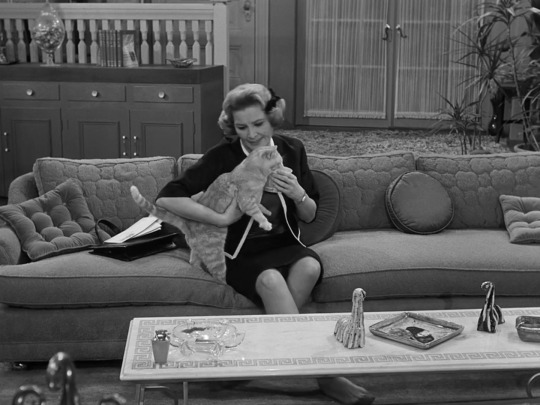



The Dick Van Dyke Show: S01E25 Where You Been, Fassbinder?
#the dick van dyke show#tv shows#rose marie#cats#my screenshots#screenshots#b/w#1960s#60s#soupy's#finally the mr henderson reveal ive been waiting for
29 notes
·
View notes
Text



WHAT IS A SWINGING SIXTIES WOMAN? YOU'RE LOOKING AT ONE, AND SHE IS LOVELY.
PIC(S) INFO: Part 1 of 2 -- Mega spotlight on a B&W photo-shoot of English actress and singer Julie Andrews, wearing a swinging, striped minidress and sandals, as she sits astride a BMW motorbike with helmet and goggles, c. 1968.
Sources: https://x.com/irenebulIock/status/1300793943496548354, Getty Images, & Iconic Images.
#Julie Andrews#Julie Andrews 1968#60s girls#Mary Poppins#Motorbike#BMW Motorcycle#Motorcycles#60s fashion#Swinging London#Female beauty#Photography#Photosession#BMW Motorbike#Actress#60s#1960s#Sixties#Vintage fashion#Retro fashion#Photoshoot#Hair and Makeup#Female form#Mini dress#Mod Style#B&W photography#Movie Actress#Motorcycle#Legs#B&W#BMW
0 notes